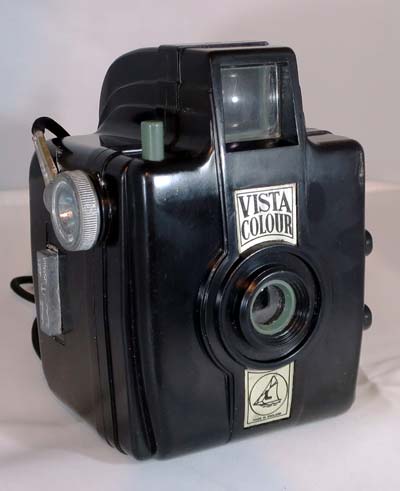E. Elliott Vista Colour
Specification

| Manufacturer | : | E. Elliott |
|---|---|---|
| Produced | : | 1940 |
| Classification | : | Medium Format |
| Body Type | : | Solid Body |
| Construction | : | Bakelite |
| Film Type | : | 120 |
| Film Width | : | 62mm |
| ImageSize | : | 2¼ x 2¼ |
| No. of Images | : | 12 |
| Lens Type | : | meniscus |
| Focus Type | : | Fixed |
| Focal Length | : | 75mm |
| Focal Range | : | 10ft - inf. |
| Aperture Type | : | Fixed |
| Aperture | : | f/12 |
| Shutter Type | : | Guillotine type |
| Shutter Speeds | : | I*1/80s |
| Size (w x h x d) | : | 100 x 125 x 95 mm |
| Weight | : | 355g |
| * Measured on this camera | ||
Art Deco Credentials
![]()
![]()
Acceptable: Modest and restricted
- Produced just after the main Art Deco period.
- Polished Bakelite
- Curvilinear body design
- Curved moulding detail on the sides
- Viewfinder shows stepped pattern on sides
- Concentric circular mouldings around lens
- Rounded body corners alluding to Streamline Moderne
Description
This is a simple Bakelite camera produced in the early 1940s. There is another camera which is called the Vista 12 which is almost identical. However, the Vista 12 has flash contacts on the side of the camera. The Vista Colour just has protuberances in the Bakelite where these contact would go.
The shutter release is on the top of the camera which only works in instantaneous mode. Film advance is by a knob and there is a red window on the back to view the frame numbers. The viewfinder is quite large compared with its contemporaries and is of Galileo type.
How to Use
This camera takes 120 film which is easily available. Don't forget to cover the red window except when advancing the film. This should be done in low light. Modern film is sensitive to red light.
The measured shutter speed on this particular camera was 1/80s. Some people guess at 1/30s which is obviously way off in this case. As you can see, it's so important to find out the true speed if you want reasonable success in getting the best exposure.
If you don't want to bother with an exposure meter, follow the guide shown. It is based on the 'Sunny 16' rule. Film is so forgiving and will produce acceptable results even when overexposed by 2 or 3 stops or underexposed by 1 stop.
The tables assume that the sun is at least 30 degrees above the horizon - that's 10am - 5pm on a summers day (May - August) in the UK.
Remember that the exposure guide in the manual may not be helpful as it is based on the use of old film with a low ISO value.
Using ISO 100/125 film - shutter speed 1/80s
| Weather Conditions | Shadow Detail | Aperture | Exposure |
|---|---|---|---|
 Sunny SunnySnow/Sand | Dark with sharp edges | f/12 | +2 Stops Overexposed Acceptable |
 Sunny Sunny | Distinct | f/12 | +1 Stop Overexposed Acceptable |
 Slight Overcast Slight Overcast | Soft around edges | f/12 | Good |
 Overcast Overcast | Barely visible | f/12 | -1 Stop Underexposed Acceptable |
 Heavy Overcast Heavy Overcast | None | f/12 | -2 Stops Underexposed Not Acceptable |
 Open Shade Open Shade/Sunset | None | f/12 | -3 Stops Underexposed Not Acceptable |